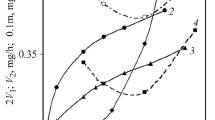Abstract
We studied the fracture of vacuum-arc Ti–N coatings, produced under a nitrogen pressure (P TiN) from 1 to 103 mPa, after their bombardment with polyenergetic deuterium ions and the action of cavitation in tap water on them without ion irradiation. We showed that, in the case of action of cavitation on nonirradiated specimens of the coatings, their erosion rate can be evaluated from the relation V c = C/(W 0.75 H 0.5). It was established that, after ion bombardment, the erosion rate under conditions of cavitation decreases by a factor of 1.5 for coatings where P TiN > 100 mPa and increases by more than 30 times for P TiN < 20 mPa as compared with nonirradiated specimens. The results obtained were analyzed using the phase diagram of the titanium-nitrogen system.
Similar content being viewed by others
REFERENCES
V. I. Kovalenko and V. H. Marynin, “Instrumentation for studying the erosion of coatings under microimpact action,” in: Problems of Nuclear Science and Engineering, Ser. “Physics of Radiation Damage and Radiation Materials Science,” Issue 5(71) (1998), pp. 83–85.
S. I. Solodovchenko, A. F. Shtan', E. V. Trofimenko, et al., “Characteristics of a facility with an electron-cyclotron-resonance discharge for the ionic-plasma technology,” in: Proc. III Interregional Conf. “Thin Films in Electronics” [in Russian], Vol. 1, Moscow (1992), pp. 13–15.
I. I. Aksenov, S. I. Vakula, V. G. Marinin, et al., “Strength of diamond-like carbon coatings under cavitation conditions,” Diamond Related Materials, 1, 549–552 (1992).
V. I. Kovalenko and V. G. Marinin, Fracture of Ceramics under the Action of Cavitation [in Russian], Preprint of the Kharkov Physicotechnical Institute No. 88-65, Moscow (1988).
V. I. Kovalenko, V. G. Marinin, and I. T. Ostapenko, “Properties of superhard materials based on nonmetallic compounds,” Sverkhtverdye Mater., No. 5, 23–25 (1984).
A. G. Evans and T. R. Wilshau, “Quasi-static solid particle damage in brittle solids. 1. Observation, analysis and implication,” Acta Metall., 24, 936–956 (1976).
C. M. Preece (editor), Erosion, Academic Press, New York (1979).
O. T. Tsyrul'nyk and A. I. Bassarab, “Structural sensitivity of steels to corrosion fracture under the action of fatigue and cavitation,” Fiz.-Khim. Mekh. Mater., 35, No. 4, 120–124 (1999).
A. G. Evans and E. A. Charles, “Fracture toughness determinations by indentation,” J. Amer. Ceram. Soc., 59, No. 7-8, 371–372 (1976).
J. M. Mousson, “Pitting resistance of metals under cavitation conditions,” Trans. ASME, 59, 339–408 (1937).
I. N. Bogachev, Cavitation Fracture and Cavitation-Resistant Alloys [in Russian], Metallurgiya, Moscow (1972).
V. V. Fomin, Hydroerosion of Metals [in Russian], Mashinostroenie, Moscow (1977).
L. I. Pogodaev, Yu. N. Tsvetkov, and N. F. Khomyakova, “Effect of the rigidity of stressed state on the wear resistance of materials in the course of hydro-and impact-abrasive wear,” Metalloved. Term. Obrab. Met., No. 4, 22–30 (1997).
V. V. Fedorov, V. I. Pokhmurskii, E. V. Demina, et al., “Changes in the hydrogen penetrability of 12Kh18N10T steel after nitriding, oxidation, and ion irradiation (H+, N+ ),” Fiz. Khim. Obrab. Mater., No. 5, 10–15 (1992).
E. D. Volkov, V. I. Kovalenko, and V. G. Marinin, “Changes in the properties of Zr-coatings, obtained under various nitrogen pressures, after the action of hydrogen plasma,” in: Sci. Reports Belgorod State Univ. [in Russian], Issue 2(15) (2001), pp. 26–29.
G. G. Maksimovich, V. N. Fedirko, Ya. I. Spektor, and A. T. Pichugin, Thermal Treatment of Titanium and Aluminum Alloys in Vacuum and Inert Environments [in Russian], Naukova Dumka, Kiev (1987).
H. Yoshida, K. Tokunaga, T. Hirai, et al., Evaluation of Erosion and Damage of LHD Divertor Materials, Annual Report of NIFS, Toki City, Japan (2002), pp. 228–229.
H. M. Nykyforchyn, “Manifestation of hydrogen and low-temperature brittleness in the near-threshold cyclic crack resistance of materials,” Fiz.-Khim. Mekh. Mater., 38, No. 4, 5–17 (2002).
G. V. Samsonov, Nitrides [in Russian], Naukova Dumka, Kiev (1969).
N. S. Lomino, V. D. Ovcharenko, G. N. Polyakova, et al., “Interelectrode plasma of a vacuum arc in nitrogen atmosphere,” in: Vacuum Technologies and Equipment [in Russian], Kontrast, Kharkov (2002), pp. 202–223
Author information
Authors and Affiliations
Rights and permissions
About this article
Cite this article
Marynin, V.H. Erosion of Vacuum-Arc Ti–N Coatings. Materials Science 39, 447–451 (2003). https://doi.org/10.1023/B:MASC.0000010751.88570.c2
Issue Date:
DOI: https://doi.org/10.1023/B:MASC.0000010751.88570.c2




